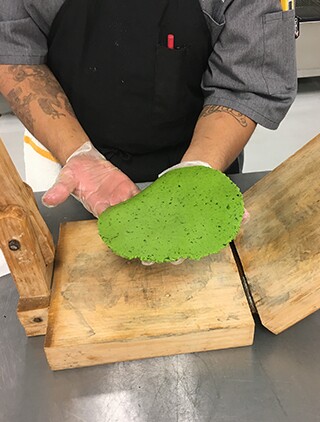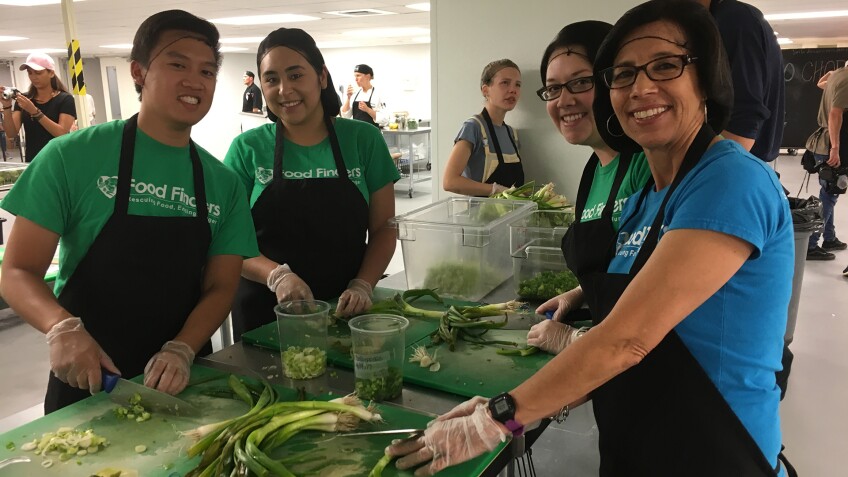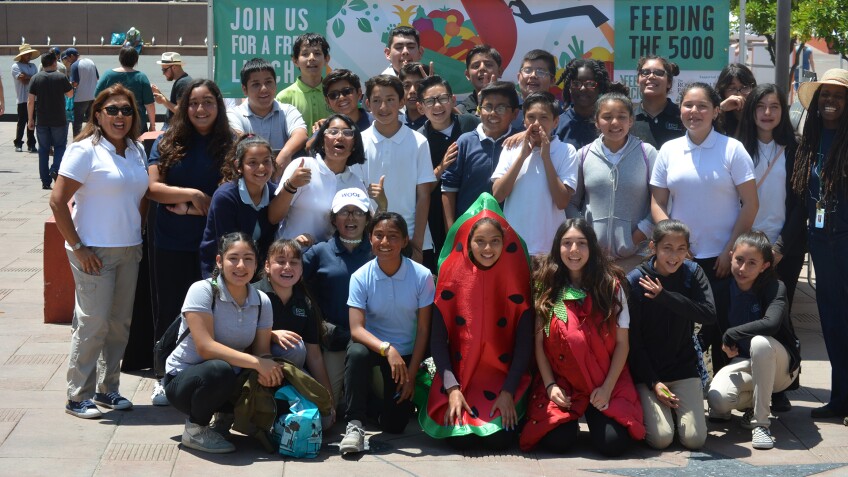How Angelenos Are Using Food Waste To Their Advantage


“California produces two-thirds of America’s fruit and vegetables and over a third of that is wasted. [The state] disproportionately bears the burden of food waste in America.” Dominika Jarosz, global campaign manager for Feeding the 5000 says.
Feeding the 5000 is a traveling global event featuring meals made entirely from food waste. Started in 2009 in the United Kingdom, it derives its name from the biblical story of Jesus feeding a crowd of 5,000 out of five loaves and two fish.
“We’re not a religious organization. But in every faith, there’s something morally wrong about wasting food,” Jarosz says. “That was the inspiration.”

The goal is to shed light on the potential of food that would typically be thrown away. The Los Angeles event, which was held in early May in Pershing Square, rescued 12,800 pounds of produce and served 5,440 meals to the public.
“We had a chef from Animal do a dish which included fish cheeks from leftover salmon heads. We also took watermelon rinds and pickled them.” Jarosz says. Also on the menu: corn tortillas made with corn and the pulp of imperfect kale.
“The free meal is what draws people in,” she says. “The goal is to inspire people to use food they would normally throw away.”
Food waste is more than just wasteful bites; it has economic repercussions as well. In the United States, 40 percent of food is thrown away, resulting in $165 billion worth of food wasted. Additionally, one-fourth of all water used in the United States is lost due to food waste, and a day’s worth of discarded bites in California is the equivalent of running a tap all day every day for 9,000 years, according to Jarosz, growing food, of course, means using water.
To put it into context, according to reports, if the country’s wasted food was grown in one place, that hypothetical farm would consume all the water used in California, Texas, and Ohio and span over 80 million acres.
In Los Angeles alone, around 18 million pounds of food are disposed of daily. Nation-wide, one out of five vegetables and fruits don’t even make it onto supermarket shelves simply because they do not fit cosmetic standards.

While Feeding the 5000 was a one-day event, it isn’t without context. Recently. the food waste movement has been gaining traction here in Los Angeles. In 2017, a Zero Food Waste Task Force was set up by the Department of Public Works to reduce the amount of waste that ends up in the dump. According to the city estimates, food waste makes up about 18 percent of our local landfills.

Also this year, Bay-area based company Imperfect Produce entered the Los Angeles market; they’re a grocery delivery service that specializes in ugly produce, both organic and conventional. Because they source ingredients that otherwise would be wasted, their customers pay 30 to 50 percent less of what grocery store produce would normally cost.
“We started delivering produce in Los Angeles in late January this year,” Reilly Brock, content manager at Imperfect Produce says. “Our first week was just a couple hundred deliveries and the response has been really warm. Los Angeles has been super welcoming. Especially because it’s a driving city, people appreciate the convenience of having a box delivered.”
In less than six months, they now have a roster of a couple thousand customers and have expanded to the greater Los Angeles area and Orange County.
“What people don’t get, and the most important thing to know about wasted food is that it represents lost profit,” Robert Egger, food activist and founder of L.A. Kitchen says. L.A. Kitchen, based in Lincoln Heights, is a reclamation kitchen that takes wasted food and transforms them into meals for low-income senior citizens.

There, they buy domestically imperfect produce at fair market value and use those ingredients to provide culinary training for foster youth, ex-cons, parolees and people who have recently come out of homelessness. The ingredients are processed into healthful meals for the elderly. His motto: Neither food nor people should ever go to waste.
“When I first started this 30 years ago [in Washington D.C.], I went to restaurants and hotels and asked for food,” Egger says. “Many charities were saying, ‘Give me food so I can feed the homeless.’ But I was saying, ‘Give me food so I can get the people on the streets trained for jobs.’”
He uses the otherwise wasted food as a tool of economic empowerment. Today, the kitchen averages about 2,000 meals a week, and since 2013, they have trained roughly 75 men and women.
“We also create a lot of jobs for older men and women. For many of them it’s their first job,” Egger says, noting that Los Angeles is home to one of the world’s largest concentrations of older adults.
What’s unique about Egger’s use of food waste is that it’s not merely just a means to an end. On top of saving the food from hitting the landfill, it creates jobs for the disenfranchised, food for seniors and a self-sustaining business.
“I don’t just want to feed the poor so they come back tomorrow and I have to feed them again,” Egger says. “Food can be used as a liberating tool.”
*All images courtesy of Feeding The 5000





